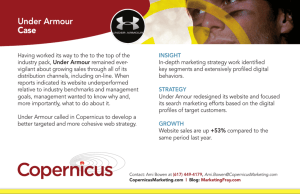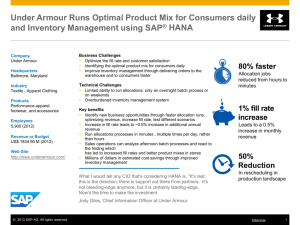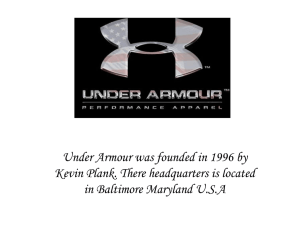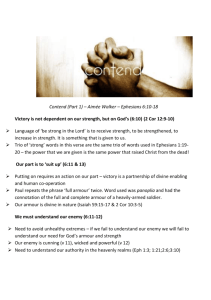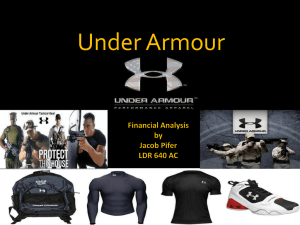Under Armour: New Product Line
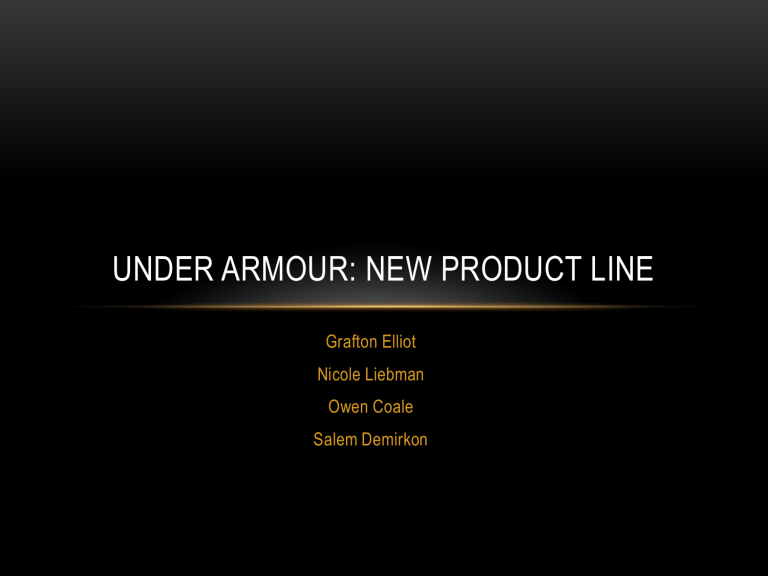
UNDER ARMOUR: NEW PRODUCT LINE
Grafton Elliot
Nicole Liebman
Owen Coale
Salem Demirkon
COMPANY PROFILE: BACKGROUND
• One of the leaders today in the sporting clothes and accessories industry.
• Based out of Baltimore, MD.
• Annual sales around $2.25 billion dollars and continuing to grow.
• Biggest competitor is Nike (Columbia, Adidas, Reebok)
• Annual revenue of around $25 billion
COMPANY PROFILE CONT…
• Under Armour offers a total of five product lines:
• Cold Gear
• Loose Gear
• Turf Gear
• All-Season Gear
• Heat Gear
• Firm focuses on innovative products
• Shirts that monitor heart rate
• Shoes that mimic the human spine
• Tape-replacing cleat
PRODUCT: UNDER ARMOUR SNOWBOARDING
BOOTS AND HELMETS
• Cold gear boots
• Cold gear helmets (Over Armour by Under Armour)
MARKET POTENTIAL
• Number of US snowboarders in 2010= 6.1 million, compared to 4.3 million in 2000.
• Women make up 33% of snowboarding market
• Global sporting events such as 2014 Sochi Olympics present exponential marketing opportunities
COMPETITORS IN FUTURE MARKET
• Industry Leader(Snowboard Boots): Nike and Burton Snowboards
• Industry Leader(Helmets): Smith
PRICE
• Men's Snowboarding Boots: $150-200
• Women’s Snowboarding Boots: $100-150
• Men’s Over Armour Helmets: $125-175
• Women’s Over Armour Helmets: $100-150
TARGET MARKET
• Users ages 12 to 24
• Largest number of snowboarder range from 12 to 24 (56%)
• Also 25 to 44 years of age (25% of market)
• These consumers tend to have a stronger brand awareness of Under Armour as well
• Both male and female
• Income level of $65,000+, people who are more affluent
DISTRIBUTION METHOD
• Today, UA uses a selective distribution strategy (multi-channel design).
• Sell to both retail as well as directly to consumers
• Online
• Principal customers: Dick’s Sporting Goods, Eastbay, and Sports Authority.
PROMOTION
• Social Media
• Television
• Billboards
• Sporting Events
• In-store promo
• Celebrity Endorsements
SURVEY & RESULTS
• Telephone interview
• 300 people called
• 50% incidence rate lowering us to 150
• 50 people refused leaving us with 100 qualified and willing to respond
SURVEY INTERPRETATION METHODS
• Correlation Tables
• Descriptive Statistics
• Pivot Tables
• Bar Graphs
• Pie Charts
• Line Graphs
RESULTS
• Negative relationship between the likelihood to purchase the Under
Armour product and the frequency of
Snowboarding/Skiing
• Demonstrates that those who are involved in snow recreation activities are less likely to buy our newly developed product
• Why?
• Brand loyalty possessed by avid snowboarders and skiiers
SURVEY RESULTS
• Quality shows to be the dominant trait for UA as demonstrated by the respondents.
• Shows that other aspects for the products need more focus such as safety and comfort.
• Safety is most likely rated lower due to
UA’s lack of actual safety products
SURVEY RESULTS
• Price Rating had the largest variance illustrating that there were a lot of mixed results for how people perceived UA’s pricing for their products
• People of Asian decent are least likely to purchase our newly developed products
• People of Hispanic decent are most likely to purchase
• Most respondents answered “4” for likelihood indicating a strong interest in purchasing
Price Paid
Boots 2
Frequency
Snowboading/
Ski
Quality
Price Rating
Durability
Aesthetics
Comfort
Safety
Gender
Race
Apparel Brand
Type
Likelihood
Income
City
Correlation Table
Price Paid
Helmet 1 Gender
1
0.047970385
Race
Apparel
Brand Type
Likelihoo d
Incom e City
1
-0.075073769 -0.006223799
1
-0.126537055 -0.020069432 0.652244413
1
0.029935223 -0.024423888 0.479677312
0.10342
2 1
-0.083069327 -0.067323291 0.389419146 0.25119
0.080257235
0.031049762 0.400891863
0.47118
1
0.161291
79
0.110789
-
4
1
0.5099
7 1
-0.042285457 -0.165011714 0.375293194
0.28461
2
0.128013
69
0.3443
1 0.404313865
Price Paid Boots
2
Frequency
Snowboading/Ski
1
Quality Price Rating Durability Aesthetics Comfort Safety
Price Paid
Helmet 1 -0.031978212 -0.146241529 0.353386014
0.33551
8
0.192697
99
0.3865
3 0.458409468
1
0.031543453
0.082872436 0.381946121
0.38143
7
0.126842
26
0.4302
1 0.522190214
0.35051
1 0.464012321
1
0.031543453
0.082872436 0.381946121
0.38143
7
0.126842
26
0.4302
1 0.522190214
0.35051
1 0.464012321
1
1 1
0.094448608
0.119230002 -0.179774984 0.02132
0.203834
1
-
-
0.1742
-0.153316655
-
0.13155 -0.156219344
0.14439
-
-0.037041486
0.029389941 -0.218591843
0.18265
0.014462
13
-
0.3747
-0.507858964
-
0.10441 -0.174737455
0.28854
-
0.20017043 -0.111493855 0.066185161
0.01325
0.078650
24 0.1987
0.021226474
0.06814
1 0.11676589
0.03102
6
0.102380116 -0.016663985 -0.063427224
0.02880
2
0.107120
03
-
0.0576
-0.064741746
0.15088
5 0.145413266 0.00242
0.036890039
0.075333094 0.044325253
0.01739
0.031407
35
-
0.0983
0.079016358
-
0.28217 -0.186812234
0.04515
5
-0.185514
0.105640162 0.012866675
0.10672
2
0.018284636
0.036500274 -0.089600383
0.00551
7
0.033060
5
0.1629
2 0.154262759
0.121150
-
8 0.0611
-
0.115307404
0.12972
3 0.172977491
-
0.03761 -0.039884761
0.02827
5
0.07279
-
-0.144391956
-0.288539831
0.031026266
0.002419754
0.045155454
0.028274856
-0.072790697
1
0.073100826
1
-0.019897703
0.0307044
49 1
0.055352822
0.0425896
73
0.05162177
7 1
0.012217837
-0.121563673
0.101766567
0.0899898
34
0.1219318
21
0.0505194
9
-
0.12015692
2 0.02284832
1
-
0.06578857
8 0.036115335 0.162016953
0.06283272
-
5 -0.198859977 0.051423543
1
0.06405726
-
2 1
CORRELATION TABLE RESULTS
• No STRONG correlations
• Stronger than normal correlation between Apparel Brand & Likelihood to
Purchase (positive)
• The table indicated that most people preferred Smith products
• City and type of item purchased(positive)
• City and consumer income(positive)
• Strongest correlation is the Apparel brand purchased and Type of Apparel
Purchased
• Indicates that most people buying helmets prefer to go with a Smith product
• Most males buying boots lean towards a Burton Product
• Women favored the idea of buying boots from Under Armour

